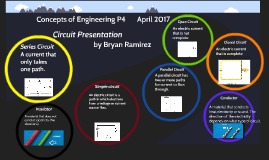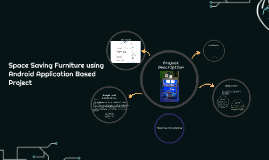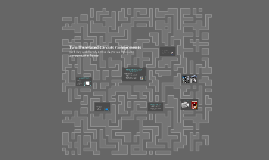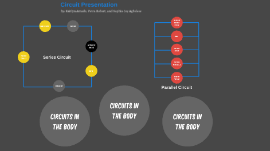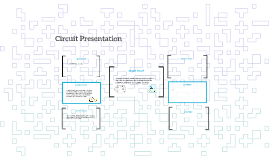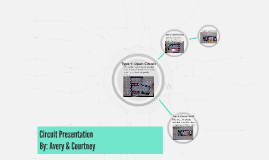Circuit Presentation
Transcript: Parallel Circuit Circuit Presentation by: Kaitlyn Amado, Petra Robert, and Sophia-Joy Agbelese Series Circuit The human nervous system is separated into two parts. These are the central nervous system (CNS) and the peripheral nervous system (PNS). Human Nervous System The Human Nervous System The central nervous system consists of the brain and spinal cord. It is referred to as "central" because it combines information from the entire body and coordinates activity across the whole organism. Central Nervous System (CNS) CNS https://www.medicalnewstoday.com/articles/307076.php The peripheral nervous system includes all of the nerves that branch out from the brain and spinal cord and extend to other parts of the body including muscles and organs. Peripheral Nervous System (PNS) PNS https://www.verywellmind.com/what-is-the-peripheral-nervous-system-2795465 The nervous system has two types of cells, neurons and glial cells. Cells in the Nervous System Cells Neurons are able to respond to stimuli (such as touch, sound, light, and so on), conduct impulses, and communicate with each other (and with other types of cells like muscle cells). Neurons Neurons http://people.eku.edu/ritchisong/301notes2.htm Glial cells are the most abundant cell types in the central nervous system. Glial cells also provide support and protection for neurons Glial Cells Glial Cells blustein.tripod.com/ Types of Nerves in the Human Nervous System Types of nerves Nerves that transmit signals from the brain are called motor or efferent nerve Motor Nerves Efferent Nerves Nerves that transmit information from the body to the CNS are called sensory or afferent. Sensory Nerves Afferent Nerves Types of Nerve Cells in a Human Body Types of Nerve Cells Nerve cells that carry information toward the central nervous system (or farther centrally within the spinal cord and brain) are called afferent neurons. Afferent Neurons Afferent Neurons Nerve cells that carry information away from the brain or spinal cord (or away from the circuit in question) are called efferent neurons. Efferent Neurons Efferent Neurons There are more nerve cells in the human brain than there are stars in the Milky Way. RANDOM FUN FACT...that isn't really fun Random Fun Fact https://www.health24.com/Lifestyle/Healthy-Nerves/10-fun-facts-about-the-nervous-system-20160210 In bulb circuits, the battery and the wires work cohesively to allow the electrons to flow so the light bulb turns on. Batteries in Bulb Circuits Batteries in Circuits The light turns on because the electron current flows through a thin wire called the filament in the bulb. Why does the light turn on? Lights There are two types of circuits, parallel and series circuits. Types of Circuits types of Circuits In a parallel circuit there are multiple paths. If one of the wires are disconnected not all of the light bulbs turn off. Parallel Circuits Parallel In a series circuit, there is one path. If one of the wires are disconnected all the light bulbs turn off. Series Circuits Series A circuit is a roughly circular line, route, or movement that starts and finishes at the same place. What Are Circuits? Bulb Circuits Sometimes in bulb circuits switches are added. These switches can start or stop the current just by moving the switch up and down Switches in Bulb Circuits Switches The brain, which is part of the CNS, is similar to a battery in a bulb a circuit. The PNS part of the nervous system is similar to the wires in a bulb circuit. (connects CNS to the rest of the body) Our body parts are similar to the lightbulbs, they are being used. Analogies similarities Epilepsy definition: a neurological disorder marked by sudden recurrent episodes of sensory disturbance, loss of consciousness, or convulsions, associated with abnormal electrical activity in the brain Epilepsy Circuits in the body What Causes Epilepsy? Circuits in the body Inherited due to genetic predisposition, called “idiopathic” or “primary” epilepsy Genetic Genetic Acquired due to some form of brain injury or improper development, called “symptomatic” or “secondary” epilepsy Other When the brain's neural circuit I damaged in a specific part of the brain, it may cause epilepsy. Damaged Neural Circuit Neural Circuits When the electrical currents aren’t working in the brain, this affects the electrical currents in the heart. This causes the heart’s electrical impulses to happen either too fast, too slow, or erratically. This causes the disease called Arrhythmia. In certain cases, this condition requires a pacemaker. A pacemaker is an artificial device for stimulating the heart muscle and regulating its contraction. This pacemaker tries to regulate the electrical impulses so the heart has a constant beat every minute. Arrythmia Circuits in the body







